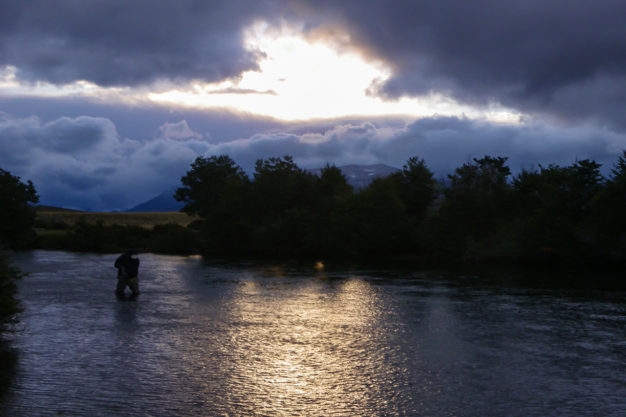Trout Bum Rio Pico
February ~ 2014
Have you ever felt the real need to go fishing somewhere that’s decidedly different than your normal spots? A place that’s so unique that you’re somewhat uneasy about it? You know, like Alaska or Tasmania or the Bahamas or Texas? Well, I’m here to tell you that that bug bites me periodically so, thus it was, that I found myself on the way to Patagonia with my long-time fishing and hunting partner, Dave Gumpel.
 Within Patagonia we ended up through happenstance fishing the Rio Pico Region which is essentially on the eastern slope of the Andes although at some point or another we were probably pretty close to the Pacific coast. The area, while quite remote by our
Within Patagonia we ended up through happenstance fishing the Rio Pico Region which is essentially on the eastern slope of the Andes although at some point or another we were probably pretty close to the Pacific coast. The area, while quite remote by our 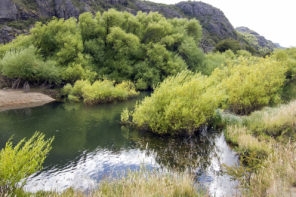 standards, is a well-known fly fishing destination with big fish, many lakes and several major watersheds. Geographically, it ranges westward from high desert, not unlike our western states, through scrub wood forests into the high alpine forests and living rock of the Andes. The primary drainage that we fished was that of the Rio Pico River, which rises in the high desert to the East of the Andes and runs through them to the Pacific, and make no mistake, folks, this is a really rural area.
standards, is a well-known fly fishing destination with big fish, many lakes and several major watersheds. Geographically, it ranges westward from high desert, not unlike our western states, through scrub wood forests into the high alpine forests and living rock of the Andes. The primary drainage that we fished was that of the Rio Pico River, which rises in the high desert to the East of the Andes and runs through them to the Pacific, and make no mistake, folks, this is a really rural area.
Let me reverse course just a tad and fill in a few blanks. I first met Justin through a mutual acquaintance who, while he had never fished in Patagonia, referred me to him. Justin and I swapped a number of emails relative to his services and the water he fished with the upshot being that Dave and I decided to go with him, a decision we never regretted.
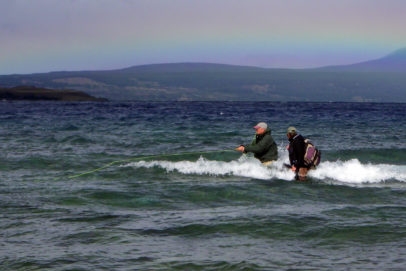 The Weather. OK, enough of the travelogue! We had wind, wind and more wind; the only day we didn’t have wind it showered. In this photo taken of me fishing a lake where a river dumps out of it; I’m standing in knee-deep water and the waves are breaking slightly over my waist – that kind of wind! That said, we never had so much wind that we COULDN’T fish; you just had to decide if you could fish effectively. To me the deciding point has always been whether or not you could cast and still fish the fly correctly. Then, of course, there’s the immutable law of nature that requires the wind to come in over your casting shoulder and slightly to the front. Essentially, we had broken clouds with some sun most of the time with a few scattered showers thrown in for good measure, but only one day without wind. It was also frequently cold and gloves helped immeasurably.
The Weather. OK, enough of the travelogue! We had wind, wind and more wind; the only day we didn’t have wind it showered. In this photo taken of me fishing a lake where a river dumps out of it; I’m standing in knee-deep water and the waves are breaking slightly over my waist – that kind of wind! That said, we never had so much wind that we COULDN’T fish; you just had to decide if you could fish effectively. To me the deciding point has always been whether or not you could cast and still fish the fly correctly. Then, of course, there’s the immutable law of nature that requires the wind to come in over your casting shoulder and slightly to the front. Essentially, we had broken clouds with some sun most of the time with a few scattered showers thrown in for good measure, but only one day without wind. It was also frequently cold and gloves helped immeasurably.
The Rods. The conventional wisdom in fishing this part of the world is that in order to take the truly big fish, you fish with 7 or 8-weight rods, very large flies and a fast sinking line or sinktip and I’m comfortable that that’s normally the case. I didn’t take any fish that a 5-weight would not have handled, but I did take them in places that a 5-weight would not have been able to muscle them out of! Much of the water that we fished was fine for a 5-weight but I think that a 6-weight added a bit of prudent insurance so that’s what I fished most of the time. Additionally, I ended up throwing some pretty heavy streamers and big wind resistant dries that would not have exactly gone hand-in-glove with the lighter rod in the wind. The one day we fished a lake via a watercraft, the 7-weights were necessary given the wind. Both of us took 5, 6 and 7-weight rods on the trip.
The Lines. The lines were probably the easiest aspect to sort out. We both took Rio Multi-tips for 6 and 7-weight rods along with full-length floaters for all three rod weights. If, however, you wanted to spend much time on lakes then you’d probably want to include one or more full-length sinking lines of different sink rates.
The Flies. We used the outfitters recommendations, and whatever else we could glean off the net, as just that, recommendations. I ended up putting together a representative  sample of just one box of flies which ranged from #18 dry attractors to #4 double-winged hoppers to Zonkers, Muddlers and Copper Johns. Beyond that, I took another three boxes consisting of one of primarily nymphs/emergers and two of streamers. Of all the flies I took, I only used 6 or 7 patterns and never felt that I needed something that I didn’t have with me.
sample of just one box of flies which ranged from #18 dry attractors to #4 double-winged hoppers to Zonkers, Muddlers and Copper Johns. Beyond that, I took another three boxes consisting of one of primarily nymphs/emergers and two of streamers. Of all the flies I took, I only used 6 or 7 patterns and never felt that I needed something that I didn’t have with me.
That said, we were expecting to find some hatches and they just didn’t happen and most likely because of the series of cold weather fronts we hit. The only day that we didn’t have some major wind (it showered) we just happened to be on a spring creek and hit a small sporadic caddis hatch where the fish seemed to be on emergers; Dave took several fish on Elk Hair Caddis. Elsewhere, Dave might have taken several other fish on dries but other than a shot at fishing a Stimulator, I didn’t fish a small dry that I can recall.
I think that at this point I need to stop and explain something about the patterns I took with me. First, in all the years that I’ve fly fished, I’ve never once concentrated on fishing for trout in moving water with streamers, big or small. The primary reason for this is pretty simple in that the moving water I generally fish doesn’t really lend itself to their use and I wanted some experience in fishing them in that manner. Everything that I read seemed to indicate that streamer fishing in Patagonia was pretty much of a big deal so I decided to concentrate on their use. Secondly, I’d never fished anywhere, or at a time, where super-sized hoppers or large Chernobyl Ants were considered standard table-fare. Consequently, it was with the above in mind that I put my selection of flies together.
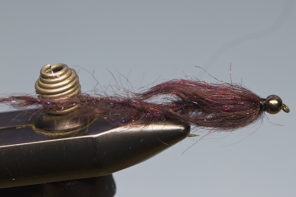 As it turned out, my two most productive patterns were ones that I tie for the high desert lakes. Both flies are tied on a #8 2xl hook and have lead on the hook shank as well as the bead head. I fished all sorts of various moving water-types and they just flat out worked. On the other hand, who knows how many other patterns would have worked just as well? Just another facet of fly fishing! Another pattern that worked well for me was a heavily-dressed #4 black marabou leech (tied for Alaska) with heavy lead eyes which I fished in the deeper runs. I also fished a large double-winged hopper on the surface and caught fish, both large and small, on it – a first for me.
As it turned out, my two most productive patterns were ones that I tie for the high desert lakes. Both flies are tied on a #8 2xl hook and have lead on the hook shank as well as the bead head. I fished all sorts of various moving water-types and they just flat out worked. On the other hand, who knows how many other patterns would have worked just as well? Just another facet of fly fishing! Another pattern that worked well for me was a heavily-dressed #4 black marabou leech (tied for Alaska) with heavy lead eyes which I fished in the deeper runs. I also fished a large double-winged hopper on the surface and caught fish, both large and small, on it – a first for me.
The Fish. As advertised in everything that you read on the subject, the browns there were absolutely lovely with large scattered spots and many of the bows looked almost like coastal cutthroat with a zillion spots. For the most part, when hooked, the browns 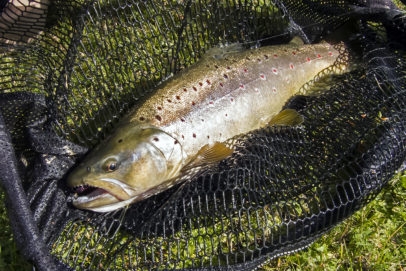 did what browns do (they know every root ball, willow sweeper and undercut bank in their domain) and the bows did what bows do best – jump. There’s no doubt in my mind that we limited ourselves in not fishing really large patterns all the time on sinktips, however, the majority of fish I took were in the 20-24 inch class so I was satisfied and, interestingly, we took quite a few fish in the 12-14 inch range in the faster water.
did what browns do (they know every root ball, willow sweeper and undercut bank in their domain) and the bows did what bows do best – jump. There’s no doubt in my mind that we limited ourselves in not fishing really large patterns all the time on sinktips, however, the majority of fish I took were in the 20-24 inch class so I was satisfied and, interestingly, we took quite a few fish in the 12-14 inch range in the faster water.
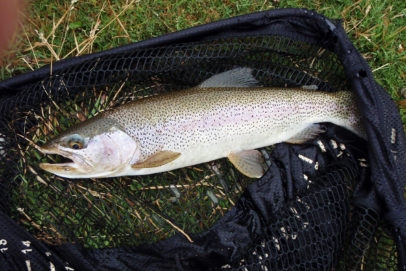 At no time did I feel that the fish were particularly leader shy and most of the time we were fishing 3x or larger tippets given the flies we were using. On the one occasion when we had some working fish on the spring creek that we fished, I had no problem taking specific fish by casting a streamer close to the rises. Willows were the tree of choice along much of the Rio Pico we fished and I lost a couple of nice browns to the sweepers but landed one that I had no business landing so considered the whole thing a draw.
At no time did I feel that the fish were particularly leader shy and most of the time we were fishing 3x or larger tippets given the flies we were using. On the one occasion when we had some working fish on the spring creek that we fished, I had no problem taking specific fish by casting a streamer close to the rises. Willows were the tree of choice along much of the Rio Pico we fished and I lost a couple of nice browns to the sweepers but landed one that I had no business landing so considered the whole thing a draw.
We had two days in which we didn’t take a single fish although I hooked and lost one on each of those days. The first time we were on a lake in the miserable wind and the second time was when we fished a ‘never fail’ river for large brook trout. Three of us fished that day and two of us hooked and lost a fish. It was one of those cold nasty wet days when a front moved through. That be the way she goes sometimes!
The Water. The water was an absolute delight to fish, quite diverse and mostly user-friendly. Most of it could be easily waded at the riffles and had a firm gravel bottom but water clarity varied widely, which made it all the more interesting. For 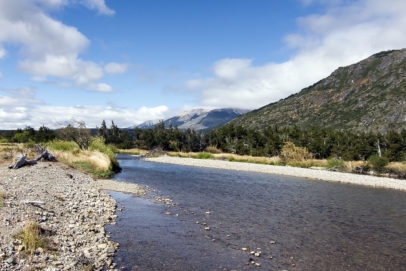 instance, the spring creek we fished probably had the poorest visibility with about 18” with quite a bit of suspended sediment but good color. One area on the Rio Pico was deep, very slow, willow-lined and had all the ear-marks of a big fish factory, however, the visibility was most likely no more than 2 feet. Some water was clear enough to sight-fish with ease; then there was the ‘gorge’ we fished with little room for a backcast and heavy flies fished in a dead drift.
instance, the spring creek we fished probably had the poorest visibility with about 18” with quite a bit of suspended sediment but good color. One area on the Rio Pico was deep, very slow, willow-lined and had all the ear-marks of a big fish factory, however, the visibility was most likely no more than 2 feet. Some water was clear enough to sight-fish with ease; then there was the ‘gorge’ we fished with little room for a backcast and heavy flies fished in a dead drift.
Odds and ends. Our outfitter was Patagonia Unlimited, in the form of Justin Witt, and he did a great job in meeting our desires and needs. We were both highly impressed with the variety of water we fished and the quality of fishing we found. The specific water types we fished were at our request; you can’t beat that with a stick, and the food and wine were nothing short of outstanding.
 It’s hard not to compare our experience in Patagonia with New Zealand but when I attempted to do so I found that the contrast is too great. The best I can do is to say that most likely the opportunity to take truly large fish, 10 pounds or better, will happen in Patagonia on a guided trip on a lake. If self-guided trips are to your taste, then by all means go to New Zealand with its easy access to good water. The opportunity to fish over several fish 4 pounds and above each day is not unusual and a wealth of material is available as to where, when and how to fish. From another side of the coin, I saw more folks (5, with two being in an inflatable) fly fishing in Patagonia then I did on my last trip to New Zealand (3, with two being in an inflatable). While it’s completely subjective on my part, I feel the fish in Patagonia are stronger and fight better than those in New Zealand. Based on the above decision-breaking information then, it’s easy to see which way you should decide to go.
It’s hard not to compare our experience in Patagonia with New Zealand but when I attempted to do so I found that the contrast is too great. The best I can do is to say that most likely the opportunity to take truly large fish, 10 pounds or better, will happen in Patagonia on a guided trip on a lake. If self-guided trips are to your taste, then by all means go to New Zealand with its easy access to good water. The opportunity to fish over several fish 4 pounds and above each day is not unusual and a wealth of material is available as to where, when and how to fish. From another side of the coin, I saw more folks (5, with two being in an inflatable) fly fishing in Patagonia then I did on my last trip to New Zealand (3, with two being in an inflatable). While it’s completely subjective on my part, I feel the fish in Patagonia are stronger and fight better than those in New Zealand. Based on the above decision-breaking information then, it’s easy to see which way you should decide to go.
